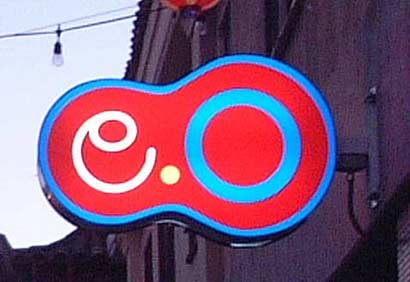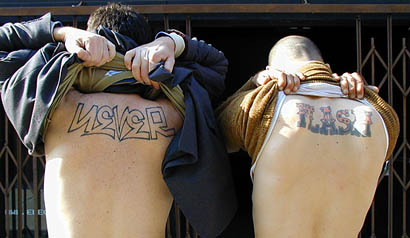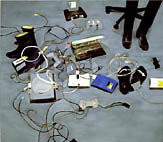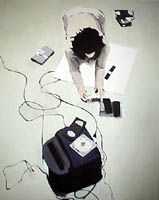|
[March 6th. 2002]

"Great artists are cleaning ladies"
Interview with Miltos Manetas
Miltos Manetas is the net.art pioneer, who believes
great artists are cleaning ladies. Manetas is born in Athens, has
studied in Milan and now lives and works in L.A. In this mail interview
he explains about the art movement Neen, the project Electronic
Orphanage and his present work with whitneybiennial.com — a
new project that opens March 7th along with the real Biennial at
The Whitney in New York City. By Kristine Ploug, Jan Johansen
and Line Rosenvinge.
You are an 'original artist'. Do you know much about art?
Not really: some recent stories (from Manet to Vanessa Beecroft)
and some confused information I have by looking at pictures at
the museums.
What is Neen?
Neen is a state of mind in a digital world. It’s also an
art movement and a movement of ideas. Social Neen (www.neen.org)
is against intellectual property and pro open source and many
other things. It's under construction.
It started in May 2000 when we commissioned the name at Lexicon
Branding (the company that made Powerbook and Pentium ) and they
delivered Neen - a word created by a computer program. In old
Greek it means exactly now, not a second later which is significant
because it obliges to reconstruct your self as often as possible.

Miltos Manetas (to the left).
So Neen is more than a word, more than a surface?
A word is a surface, a platform and an excuse to change the state
of things. Not because things are any bad but because there is
not much else to do in a comfortable world.
Most of your texts end with a 'to be continued'. Why?
See, things today have only present. Yesterday's reality is
just literature. We have to build a way of functioning with that
in consideration.
The Neen-Manifesto remains dated 2000, however, it is continuously
updated. Why don´t you change the date?
I forgot...
CABL2x.jpg) MADONx.jpg)
(left) Miltos Manetas: Cables on the floor
, 1999 Oil on canvas.
(right) Miltos Manetas: Madonna and Child, 1998 Oil
on canvas.
Why is it sufficient to know a word but not its content? Person
of the Month of November is Jeffrey Deitch for FFF (Form Follows
Fiction). FFF is a concept, a book and a show. You prefer to experience
the three letters FFF only?!?
Yes, I believe in words more than what I believe in concepts,
books or exhibitions. I cannot explain that now. Maybe later...
You are known to say that knowledge slows us down. How do
you avoid accumulating knowledge in modern times?
I don't know about that: it is like asking a keyboard if typing
is slowing
it down. The only thing a keyboard knows is keystrokes.
What is your new site whitneybiennial.com going to be about?
Whitneybiennial.com is a website and an exhibition that will open
in sync with the Whitney Biennial at the Whitney Museum of American
Art. Twenty U-Haul trucks with their back door open and transformed
to a screen (we will install a computer and a projector inside
each of them) and will circle around the Whitney Museum for the
two nights of the Whitney Party and for the day of the opening.
Think of Mondrian's Boogie Woogie activated. It will be a super
parasite: a snake against a cow. A cow, as well as the institutional
show, is large, slow and shortsighted, instead a snake is fast,
clever and experimental.
The Whitneybiennial.com, will be an adventure: the most important
international artists - but also designers, internet geniuses
and architects, are invited to contribute a short Flash piece
(30 sec max) to a collective Flash animation. It can be either
an artwork or their logo. Film previews are today usually better
than the actual films: the Whitneybiennial.com will be a collage
of previews: an aesthetic manifesto for our times.
 
(left) Miltos Manetas: Cables and Legs,
1998 Oil on canvas.
(right) Miltos Manetas: Paulina on table, 1999 Oil
on canvas.
Why will they all do a Flash animation?
It is an experiment. We believe that as Peter Lunenfeld writes
at the KLM theory, "Flash is today's Pop". In fact, Flash is an
easy technology which lets you draw a cartoon or a logo, animate
it and even make it interactive. The user will click on it and
the cartoon (or logo) will reply. It brings together all other
forms of art such as photography, written text, movies and drawing
in such a way that makes contemporary art of the past century
look like a proud grandfather. Flash is, again according to Mr.
Lunenfeld, "PoliTech, the irrepressible joy and lightness
of being digital after the boom economy has gone bust." It
is also scalable, that means that you can display it on different
dimensions without any loss of quality. With very little budget
and in a short time, you can do something that looks better than
any "art video". It relates to real space as well as it relates
to the Internet and substitutes any need for heavy duty art installations.
The only thing that you cannot do with Flash is to put a dead
cow in a glass box, but who does want to do that anymore?
Whitneybiennal.com opens at the same date as the biennial
at Whitney Museum of American Art. You compare your site to a
snake and Whitneys Biennial to a cow. Do you care to elaborate
more on the difference between the two (Whitney has a history
of also doing net.art along with their tangible art).
Fuck the Whitney's selection. What a museum selects is not
important. What is important is what artists and the theoreticians
who work close to them are selecting. Nobody wants to go visit
AOL's art section. Institutions are cultural AOL.
What is the Electronic Orphanage (EO)?
Here is the plan for the EO: EO is a sore front in Los Angeles,
at Chung King Road. This is a pedestrian street, hosting the best
young art galleries and designers. I opened EO in February 2002.
It's a black cube, where a large screen is left white for projections.
When the galleries in the street have openings, EO is showing
a piece, commissioned for the occasion. The rest of the time,
it´s a studio where people (the Orphans) are "working" on
Neen and Screen ideas. We are planning to open soon an EO in Shanghai,
China and Goa, India. People will travel between the different
locations.
Here are the EO basics:
1.The space is visible only from the outside, the public is not
allowed inside. (EO is not a gallery. It shouldn't even be a space
but...)
2. People are hired. Their job is Computer Safari.
4. Nothing is required from them other than a demonstration of
"Screen Intelligence". They may be able to design a great website,
invent a new word, play a videogame or they may just find an interesting
website and display it. The less their effort, the more they will
get paid. "Work" is not encouraged.
5. The space of the EO is a demo room. Selected guests will show
"stuff". These projections are not intended as "art " but some
may become art later. Boring or very conceptual pieces are not
welcome. Who decides what is boring is myself and my friends.
6. Nothing is for sale and everything that is produced in the
EO is copyright free.
7. EO is not oriented towards education, everybody has already
enough of that.
7a. And of course, we are not "designers".
8. EO stays on a borderline in between private and public. Example:
a writer is invited to come and write his book on the EO and get
paid while he does that. He can project his text, for everybody
to see. EO is indented as a "view over the shoulders".
9. Hardware and software in the EO must be the "top of the line"
quality.
10. Creativity is welcome but not required. Style instead, yes.
11. EO is "on" all day and all night 7/24. Everything that happens
on the EO screens, can be seen on the Web (not yet ready).
12. Even if the real world hosts EO at the Los Angeles Chinatown,
this location is random. EO will soon open at Shanghai, China
and at Goa India. The location is not important.
13. People inside the EO are welcome to behave like Avatars.
(The Avatar Behavior is not yet mapped)
 
(left) Miltos Manetas: Christine on Playstation,
1999 Oil on canvas.
(right) Miltos Manetas: Levis with cables, Oil on
canvas.
What happened at the 'situation'you created at Deitch Project
in NYC in the beginning of November 2002?
There was a wire, separating the people that were involved with
the show and their friends/guests from the regular public. They
could all look at the same large projection of the biennale.net
(www.biennale.net) works. There was a lot of discussion. Here
are all details: www.electronicorphanage.com/biennale/voice.htm
What is the connection between your tangible work and your
digital work? - What do you add to the experience of hardware
by painting it?
It's again classic. By painting something, you cancel it. Great
artists are not really artists but cleaning ladies: they remove
sense from forms (because forms invite our brain with their sense)
and they do that by creating new sense around forms. It's the
same job a cleaning lady does with trash: she collects it from
different places in a room and makes a pile in a corner. Ultimately,
everything gets thrown away and we can go on.
NIKECx.jpg) RGBx.jpg)
(left) Miltos Manetas: PlayStation with
Nike Shoes, 1998 Oil on canvas.
(right) Miltos Manetas: RGB, 1998 Oil on canvas.
Is copy-paste the new aesthetic?
It's a classic aesthetic, it has been used by everybody (the Greeks,
the Romans etc). The new aesthetic is an updated use of copy-paste:
a magnification of the identity value that's included in your
copy-paste without much effort, virtually none. I dream of a time
when people will do their artwork themselves because it will be
a pertinent work for them to do and you will have to do nothing
else than enjoy the credits. The best artists will be the ones
whose projects voice a larger frame of possibilities and who are
working less.

From www.worldplusplus.com
Many of your projects are dedicated to other persons or directly
linked to their projects. Is this a conscious strategy, and why
is it so?
People are ideas. When I link to them, I feel as building a new
machine. I don't even see any personality in people anymore. Just
floating ideas.
What do you achieve from online networking?
I don't know yet, I don't really care. I do it because I have
a lot of time to spend.
What do you lose from online networking?
There is nothing to lose (and nothing really to gain...)
Please recommend three places to go on the Internet (other
than those you yourself are involved with)...
1. Design: NewsToday.com
2. Mirror: http://www.amihotornot.com/
3. http://www.metaspy.com
More Manetas...
www.manetics.com
www.neen.org
www.electronicorphanage.com
EO curated the internet section of the Tirana Biennial. See more
here: http://www.electronicorphanage.com/biennale/
|